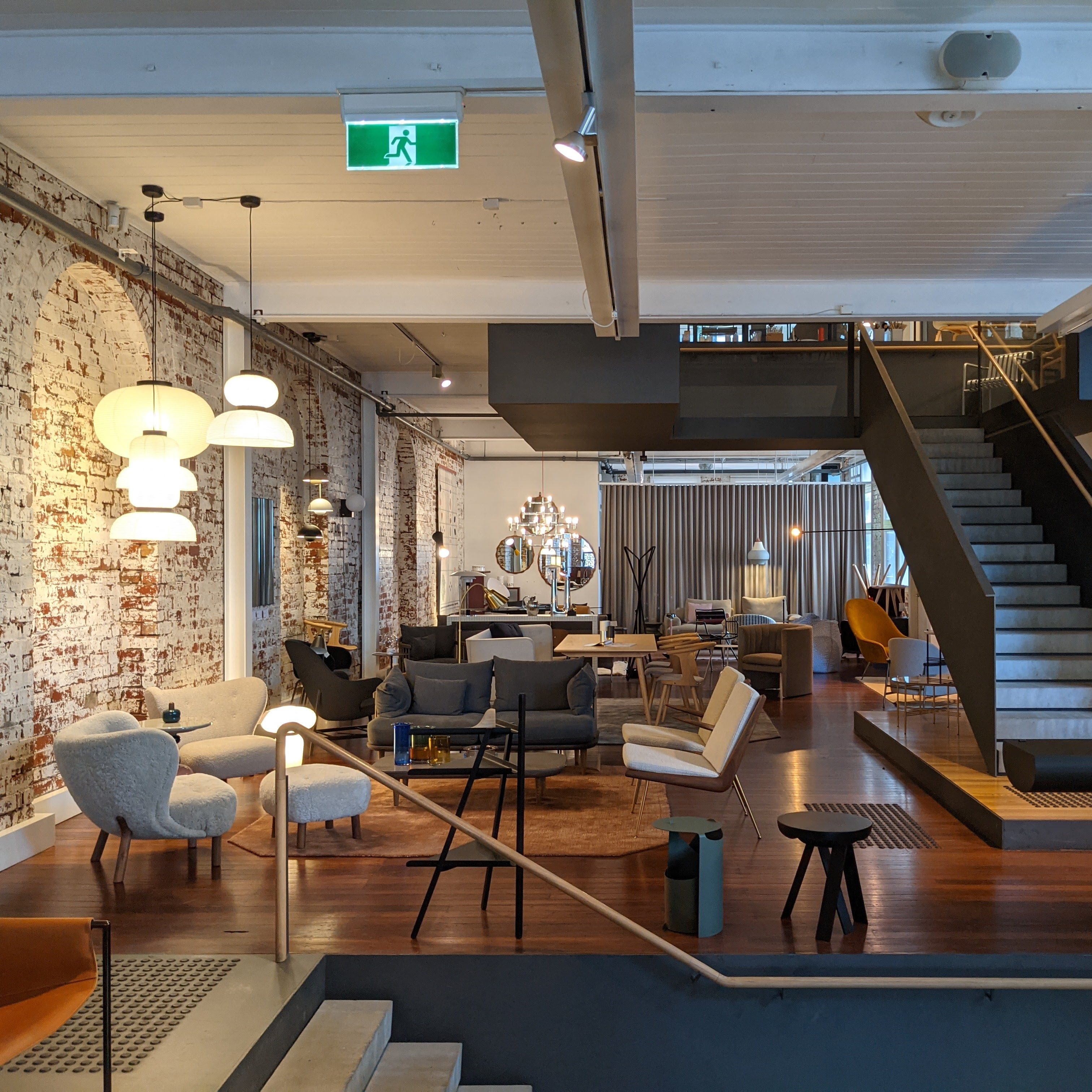by Miller Keys and Eilish Jackson
Showcasing what it takes to create a circular economy within the furniture industry, Cultivated is a captivating exhibition that restores hope to its visitors. Located in Cult Design’s Melbourne showroom, the exhibition displays a number of restored pieces, as well as items from local designers, and a short film exposing the wasteful practices that drive the manufacturing industry.
As part of Melbourne’s Design Week 2021, Cultivated is true to this year’s theme: ‘Design the world you want’, and the three pillars that uphold this: Care, Community, and Climate. From the moment one enters the exhibition, you get a sense of the true appreciation the Cult team have for their products, those who design them and those who create them.
Cult’s showroom creates the ideal backdrop for the exhibition. Located on Melbourne’s iconic Elizabeth street, the building features original brick walls and large glass windows. Every detail of the building’s interior has been meticulously designed, from stair railings to the curtains, which only adds to the experience and reinforces the notion that good design must be appreciated and cared for.
The 1955 Series 7 Chair designed by Arne Jacobsen is an integral element of Cult’s circular design process. At the beginning of the exhibition, the chair is displayed in various stages of its life cycle. The resurrection by the Cultivated studio, including sanding, painting, and even upholstering to create something seemingly new is shown, while explaining the process on banners hanging behind them. Importantly, these chairs were not just made for the exhibition: each chair was acquired by the Cultivated initiative after a long life in service from many locations throughout Australia. Several have found new homes for continued service post-cultivation.
The exhibition’s layout invites visitors to walk through each step taken to restore pieces of furniture. Guests view the before and after of a few classic items, before settling in on a quintessential Series 7 chair for a short film featuring several Australian designers and creators. They speak of their experiences with waste in the industry and how they are working to change it. Although the film leaves very few questions unanswered, the Cult staff are eager to inform and interact with their visitors and they are evidently proud of the work they have done to create change in such a conservative area.
Cult brand manager, Joshua Ellis, was especially excited to explain how many of the fabrics are made from the same material as plastic bottles, polyester, and was proud to announce that they have partnered with a textile factory being built on the Australia’s Gold Coast, which intends to use both recycled textiles and plastic bottles to create new upholstery materials. Ellis explains the recycling process and how the materials might be used, which certainly gives a greater understanding and appreciation of the work that goes into creating each piece upon visiting the showroom. What stood out about this, however, was that the factory will not be opened for another 12 to 24 months and Cult have already started saving fabrics to send to them, which testifies to the fact that this project is not just a concept or scraps of hope for a better world – these people are making it happen.
After visiting the ground floor, visitors are encouraged to make their way through two levels of showrooms, which display only the best of furniture design (along with the biggest of price tags). While these products are a showcase for grand design of sustainable products, they also demonstrate that ideas like Cultivated don’t come cheap. Many of the products cost well into the thousands and sometimes even tens-of-thousands of dollars, which clearly isn’t within the average home decorator’s budget. This highlights that although Cult is doing important work, until more “wallet friendly” businesses start implementing similar processes, people are not likely to jump on this bandwagon too casually. After visiting Cultivated, it is difficult to see how these processes could be made cheaper before becoming mainstream, and even then, this runs the risk of devaluing the exceptional craftsmanship involved. This is information that was omitted from the exhibition, as Cult’s demographic are very clearly people with large wallets and a strong appreciation for good design. It will take some time to overcome this issue, and that is time that is simply unavailable.
The final stop is the third floor which has been arranged into a studio apartment. Complete with a kitchen and bathroom, the room has been created using only items from Cult’s Nau collection. The apartment is an exciting look into the future of Australian residential spaces, utilising furnishings which are not only Australian designed and made with the best materials, but are designed for longevity, styled to individual taste, and can be repaired many a time so as not to contribute to landfill. Although beautifully arranged and a dream for those with a keen eye for design, this only raised more questions about how it could be made available to those who do not have the money to spend in these situations.
Not only does Cultivated showcase the ways in which furniture and lighting can be restored for longevity, it also invites people to discover new, more environmentally sustainable material options and how these new materials can be used across multiple settings. It is incredibly important to showcase the hard work of people like those at Cult, who are finding innovative ways to change the way people think about products, while simultaneously taking action in regards to sustainability practices. Although some might see the challenges that arise out of this new way of doing, the exhibition answers more questions than it raises. Cultivated is for both novices and experts alike, who will walk away with a renewed sense of hope for the world.
Photo by Miller Keys and Eilish Jackson


Leave a Reply